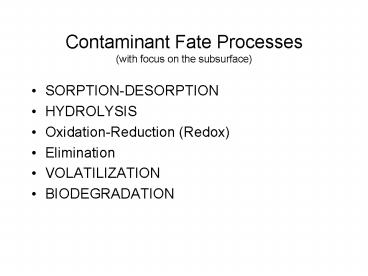Contaminant Fate Processes with focus on the subsurface - PowerPoint PPT Presentation
1 / 21
Title:
Contaminant Fate Processes with focus on the subsurface
Description:
Metabolism = anabolism catabolism ... Catabolism: the biochemical processes leading to the production of energy ... Catabolism and the source of the energy ... – PowerPoint PPT presentation
Number of Views:23
Avg rating:3.0/5.0
Title: Contaminant Fate Processes with focus on the subsurface
1
Contaminant Fate Processes(with focus on the
subsurface)
- SORPTION-DESORPTION
- HYDROLYSIS
- Oxidation-Reduction (Redox)
- Elimination
- VOLATILIZATION
- BIODEGRADATION
2
SORPTION-DESORPTION
- Generally accepted nomenclature
- Absorption the dissolution of gas molecules
into bulk liquid. - Adsorption physical, reversible attachment of
gas (or liquid) molecules to a solid surface - Chemisorption the attractive forces between gas
molecule and surface are closer to chemical
bonding than physical attraction. - The term Sorption is used to avoid having to
make the distinction,
3
SORPTION-DESORPTION
- BRN subsurface contaminant nomenclature
- Absorption the dissolution of contaminant into
bulk solid. - Adsorption attachment of contaminant to the
solid surface - Sorption is used for the sum of the two
processes - Desorption - return of the contaminant to the
bulk fluid phase - The significance of sorption is that it causes
the contaminant to be retarded relative to the
movement of the bulk fluid phase
4
(No Transcript)
5
(No Transcript)
6
Abiotic processes
- Chemical reaction mechanisms that do not include
the direct involvement of living organisms
7
HYDROLYSIS
- Chemical interaction between contaminant and
water - Do not include direct involvement of living
organisms, thus abiotic - Some contaminants are more susceptible to
hydrolysis than others, Tables 7.3 and 7.4 - Strongly dependent on temperature and pH
8
(No Transcript)
9
(No Transcript)
10
Oxidation-reduction (another abiotic process)
- Transfer of electrons between contaminant and
other species (Fig 7.4) - LEO-GER (Lost electrons oxidized, gained
electrons reduced). - Electron donors, acceptors (I.e.reducing or
oxidizing agents) - Halogenated hydrocarbons and nitroaromatics known
to undergo abiotic oxidation-reduction reactions
in anaerobic subsurface environments
11
(No Transcript)
12
Elimination(another abiotic process)
- Release of a halogen group and a proton from an
adjacent carbon in halogenated ethanes and
propanes, followed by the formation of a CC
bond. - 1,1,1 trichloroethane to 1,1 - dichloroethene
- Correct the figure to show CC bond instead of C-C
13
VOLATILIZATION
- Transfer of contaminant from aqueous, organic, or
adsorbed phase to the gas phase - (Transfer from adsorbed phase to gas phase also
called desorption) - Aqueous-gas phase equilibrium described by
Henrys law coefficient seen earlier, e..g.
14
BIODEGRADATION
- Conversion of contaminant to mineralized end
products (CO2, H2O, salts) through metabolism by
living organisms (bacteria) - Biotransformation conversion of contaminant to
another chemical form, but not mineralized end
products
15
Metabolism anabolism catabolism
- Anabolism the biochemical processes involved in
the synthesis of cell constituents from simpler
molecules, usually requiring energy - Catabolism the biochemical processes leading to
the production of energy
16
Catabolism and the source of the energy
17
Catabolism and the source of the energy
- The extraction of energy from organic chemical
forms involves their oxidation (I.e. losing
electrons) - Thus chemotropic substrates (food for bacteria)
are primary electron donors - There must also be terminal electron acceptors at
the end of complex oxidation-reduction reactions - O2 aerobic,
- NO3 Fe3, SO4-2, CO2 anaerobic
18
Dissolved oxygen effects in the subsurface
- Presence or absence of oxygen determines the type
of bacteria that can survive - Direct participation of oxygen in reactions
catalyzed by oxygenase enzymes (Fig 7.7) - Examples, benzene, fuel constituents, PAHs, some
chlorinated solvents etc.
19
(No Transcript)
20
Contaminant biodegradation
- Evaluate the availability of
- Primary electron donors
- Terminal electron acceptors
- Definitions
- Primary substrate primary electron donor
providing the energy for cell growth - Secondary substrate provides energy but not
sufficient for all energy needs - Cometabolite a compound metabolized as a side
process while the cell is deriving energy from
another primary substrate
21
Common subsurface contaminants
- Monoaromatic hydrocarbons Benzene, toluene,
ethylbenzene, xylenes (BTEX) - Polynuclear Aromatic Hydrocarbons (PAH)
- Phenolic compounds
- MTBE
- Chlorinated solvents
- Nitroaromatic compounds
- Biodegradation pathways for these compounds is an
active area of research.































